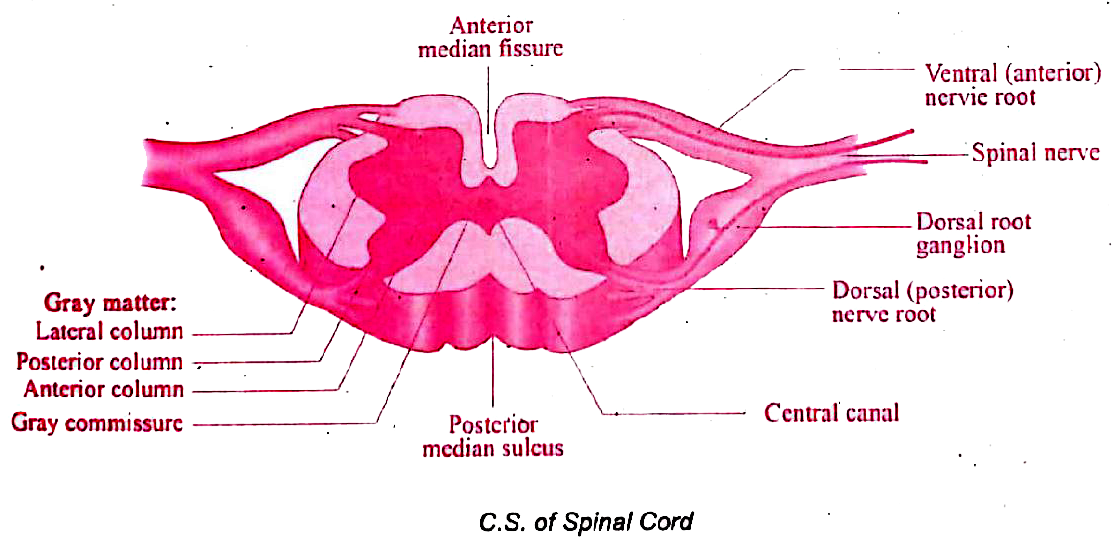Explain C.S of spinal cord with neat diagram.Solution in Tamil

In the cross section of spinal cord, there are two indentations: the posterior median sulcus and the anterior median fissure. Although there might be slight variations, the cross section of spinal cord is generally the same throughout its length. In contrast to the brain, the grey matter in the spinal cord forms an inner butterfly shaped region surrounded by the outer white matter. The grey matter consists of neuronal cell bodies and their dendrites, interneurons and glial cells. White matter consists of bundles of nerve fibres. In the centre of the grey matter there is a central canal which is filled with CSF. Each half of the grey matter is divided into a dorsal horn, a ventral horn and a lateral horn.
The dorsal horn contains cell bodies of interneurons on which afferent neurons terminate. The. ventral horn contains cell bodies of the efferent motor neurons supplying the skeletal muscle. Autonomic nerve fibres, supplying cardiac. and smooth muscles and exocrine glands, originate from the cell bodies found in the lateral horn. In the white matter, the bundles of nerve fibres form two types of tracts namely ascending tracts which carry sensory impulses to the brain and descending tracts which carry motor impulses from the brain to the spinal nerves at various levels of the spinal cord. The spinal cord shows two enlargements, one in the cervical region and another one in the lumbosacral region. The cervical enlargement serves the upper. limb and lumbar enlargement serves the lower limbs.
Related Playlists
- BOOK - PREMIERS PUBLISHERSCHAPTER - NEURAL CONTROL AND CO-ORDINATION EXERCISE - SOLUTION TO TEXTUAL QUESTIONS (Text Book Page No. 60 )1videos
NEURAL CONTROL AND CO-ORDINATION
- BOOK - PREMIERS PUBLISHERSCHAPTER - NEURAL CONTROL AND CO-ORDINATION EXERCISE - SOLUTION TO TEXTUAL QUESTIONS(Text Book Page No. 61)1videos
NEURAL CONTROL AND CO-ORDINATION
- BOOK - PREMIERS PUBLISHERSCHAPTER - NEURAL CONTROL AND CO-ORDINATION EXERCISE - Other Important Question & Answers ( I. Choose the correct answer.)49videos
NEURAL CONTROL AND CO-ORDINATION
- BOOK - PREMIERS PUBLISHERSCHAPTER - MINERAL NUTRITIONEXERCISE - OTHER IMPORTANT QUESTIONS & ANSWERS (Answer the following)40videos
MINERAL NUTRITION
- BOOK - PREMIERS PUBLISHERSCHAPTER - PHOTOSYNTHESISEXERCISE - Other Important Questions & Answers CHECK YOUR GRASP3videos
PHOTOSYNTHESIS
Similar Questions
Can you state why some areas of the brain and spinal cord are gray and some are white?
01:33View SolutionHuman brain is formed of a large number of parts like cerebrum, thalamus, hypothalamus, pons, cerebellum and medulla oblongata. Each part performs some specialized function and all the parts are essential for the survival of a person. Discuss the following statements :
(a) Thalami are called relay centres of the brain.
(b) Damage to medulla may cause the death of organism.View SolutionStructural and functional unit of nervous system________.
View SolutionDefine micro nutrients of plants.
04:37View SolutionName the products produced from Non-Cyclic photophosphorylation?
02:05View Solutionकपाट तन्त्रिका एवं मेरू तन्त्रिका में अन्तर बताइये ।
02:44View SolutionDraw a neat labeled diagram of T.s of spinal cord.
02:05View SolutionWith a labeled diagram , describe the structure of human spinal cord.
03:40View Solutionमेरुरज्जु की रचना व कार्य समझाइए।
07:14View SolutionExplain in the structure of spinal cord.
09:37View SolutionDraw the diagram of C.S. of spinal cord ?
04:44View SolutionExplain in the structure of spinal cord.
04:10View SolutionDraw a neat labelled diagram of the following (a) Brain (b) Structure of Spinal Cord (c ) Nerve impulse transmission
02:15View SolutionWhat is spinal cord? Describe the structure of spinal cord.
09:21View SolutionWhat is spinal cord? Which function is controlled by it? Explain.
01:27View SolutionDraw a labelled diagram of T.S. of spinal cord of man.
01:15View Solution

